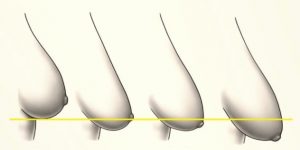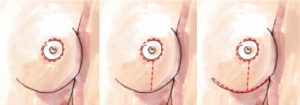 Mastopexy is plastic surgery for repositioning and elevation of the breasts and areolas after ptosis (drooping). It is indicated for patients who complain of “drooping breasts,” which occurs when the areola (nipples of the breasts) are turned down or when the breast content forms large folds at its base. It can be performed with or without the use of mammary prostheses.
Mastopexy is plastic surgery for repositioning and elevation of the breasts and areolas after ptosis (drooping). It is indicated for patients who complain of “drooping breasts,” which occurs when the areola (nipples of the breasts) are turned down or when the breast content forms large folds at its base. It can be performed with or without the use of mammary prostheses.
1. What type of anesthesia is used for breast lifts?
We can opt for local anesthesia with sedation for small to moderate size breasts. A medication is given to the patient so that they can sleep calmly. Subsequently, we perform local anesthesia on the breasts. For cases of higher volumes breasts, we should opt for general anesthesia for the patient’s safety.
 2. What are the scars?
2. What are the scars?
There are two scar options:
• Periareolar + “T”
• Periareolar + “L”
The periareolar scars are necessary for the repositioning of the areola; while the scars “T” or “L” allow the breast remodeling. The recommendation for the type of scars will depend on the degree of loss, skin quality and quantity of breast tissue to be resected in each patient. We apply Micropore adhesive dressings throughout the scar for 3 months until the final scar is as discreet as possible.
3. When will the stitches be removed?
For this type of surgery we use absorbable sutures, that is, wires that are degraded by the body after a few weeks. Thus, the stitches do not need to be removed, they will disappear by themselves.
4. Is the use of silicone prosthesis necessary?
No. If the patient is satisfied with the breast volume, the implant is not necessary. But if the patient desired breast enlargement or breast with formats more similar to those with implants, it can be used.
5. Does the silicone prosthesis ensure a more lasting result of mastopexy? And what if the prosthesis is placed behind the muscle?
No. Breast prosthesis can result in carrying weight that is more than breast skin can support, which can lead to premature decline in cases of breast prostheses that are very voluminous (and consequently, very heavy). This problem is not resolved by placing the prosthesis in the submuscular plane (behind the muscle). In fact, over time, that will create another problem; therefore, the prosthesis will be trapped by the muscles, but the breast will naturally fall on this prosthesis causing a “double bubble” shape. This shape is caused because the implant and the breast will be in different “compartments” and it this be visible.
6. What will the new size of the breasts be?
To reach a consensus on the new size of breasts that the patient should have, we must take into account numerous factors such as:
• the patient’s chest characteristics (too narrow? Too long?)
• Skin and mammary gland characteristic (presence of stretch marks? firm skin? Breast fat?)
• The patient’s wish (small breasts, proportional to the body or large volume)
The new breast volume will be extensively talked over between the surgeon and the patient so that both are satisfied with the result.
7. Can I breastfeed after surgery?
For most patients, future breastfeeding will not be affected, especially when the mammary reduction is small or moderate. For breasts of large volumes, breastfeeding may change. However, it is not possible to predict whether there will be any future damage.
8. Is the surgery very painful?
Usually there is no pain and, if it is present, it is quite tolerable. We prescribe simple analgesics for pain that the patient can take at home, prophylactically, that is, before they can feel any discomfort.
9. Does the incision get very swollen and purple?
In the first 2 to 3 days, edema (swelling) and ecchymosis (purple) may be present. But, this will depend on how each patient responds to surgery.
10. How long does the surgery last?
Usually from 2 to 3 hours.
11. How long will I need to stay in hospital?
From 8 to 24 hours after surgery. Depending on the type of anesthesia and recovery of the patient.
12. Is lymphatic massage necessary?
The massages are very important. The first massage is performed about 4 days after surgery. It helps in the early reduction of swelling and remodeling of scars.
13. How will the sensitivity of the breasts be after surgery?
In surgery, for reduction of breast volume, the breast must be taken off so that the excess is removed. With this, there will be interruption of sensory stimuli conduction by the nerves in some regions, which may be temporary or permanent. So, soon after surgery, the skin of the breasts and areolas will be dormant. As the weeks pass, there will be a gradual return of sensitivity, and most patients report near or total recovery of this sensitivity after a few months. This recovery may occur within 6 months after surgery.

